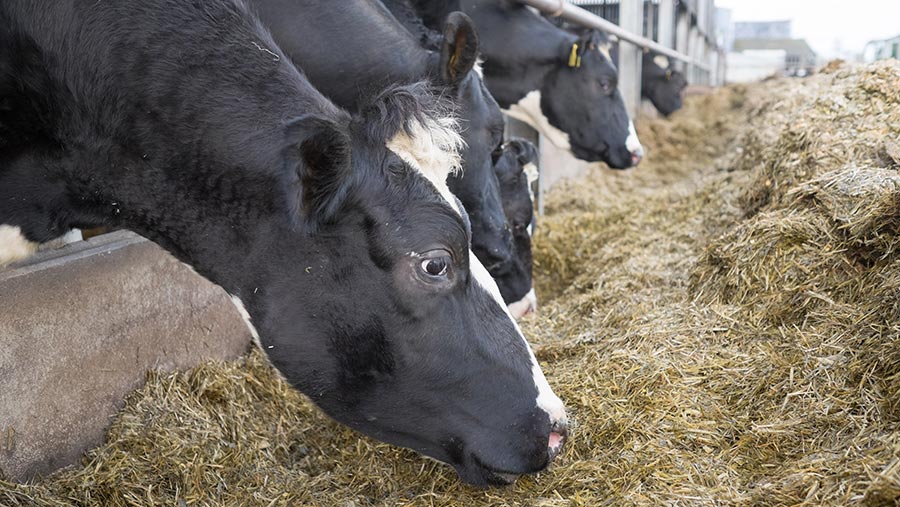Tips on feeding and cow comfort to improve fertility
 © Tim Scrivener
© Tim Scrivener Farmers could realise an extra 500-1,500kg of milk a cow by improving transition management.
A key factor is feeding because the hormone changes a cow experiences at calving reduce appetite.
Oestrogen, which is increased in close-up cows, is an appetite suppressant and reduced intake can cause disease and fertility issues.
“Issues are actually opportunities, though, because if you deal with the issue, you have removed a roadblock to cow performance,” Dr John Cook, global technical consultant at World Wide Sires.
Dr Cook’s key tips:
1. Focus on intake from eight weeks before to three weeks after calving
From eight weeks before calving the effect of the cow’s hormones on appetite is gradual and it accelerates in the close-up period. At calving she has lost the desire to eat because of her hormonal state.
The objective in this period is to slow down the decline in appetite.
See also: How to understand terms used in dairy fertility data
If a cow is consuming 9.5-10kg of dry matter (DM) a day in the last seven days before calving, she will be eating 20kg DM a day by 10 days post calving and it is almost guaranteed she will be back in calf by 100 days.
2. Turn her around quickly after calving
This is about training – to get the cow to eat again soon after calving to maintain her metabolic state, milk production and get her back in calf.
One of the very first jobs once she has calved should be to encourage the cow to eat and drink.
3. Ensure cows are not overstocked
No cow in a close or fresh pen should ever have to compete for feed based on social rank, a stocking density of 80% in a fresh pen is recommended.
Because their appetite is already suppressed, if they have to compete to access food, it is likely they will give up easily.
4. Get cows lying down
A lying time of 10 hours is the critical threshold – cows that lie down more eat more.
Therefore, cow comfort is key – in the form of clean, dry bedding and good ventilation in buildings.
5. Minimise change
The factors around social environment are being recognised as more and more important.
Minimising any group or social changes in the transition cow will reduce stress and improve feed intake and fertility.
When the number of days cows spend in the close-up pen is less than 16 days, there is an increase in disease incidence.
6. Detect disease early and treat aggressively
Instead of referring to fresh cows with disease as “a case of metritis”, they should be viewed as a “transition failure” because it is all about management.
Metritis is not an infectious disease – it’s a metabolic disease that happens before cows calve.
Herd managers can get an early signal from cows as to whether they will have problems post calving because metritic cows often eat less before calving.
This can be picked up through monitoring, physically or by technology, and then addressed before calving.
Cows with disease in the fresh period typically produce less milk and take longer to get back in calf.
Tips on transition cow management
- Ensure there is lots of good-quality feed available at all times and plenty of space for all cows to access it.
- Allow 75cm of trough space per animal.
- Get the ration right – cows do not eat percentages, they eat kilogrammes, and if they are eating less than you predict, they will not be getting adequate nutrition.
- Cows in the close-up period should be lying for at least 10 hours a day – these are the cows that will eat more.
- Monitor cows for lying and eating before calving to pick up on potential disease risks post calving. Metritic cows often eat less before calving.
On-farm monitoring
Dr Cook advises some farmer clients to monitor lying times in close-up cows by doing the following:
- Check cows at the same time each day, ideally around two hours after feeding, and list the cows stood up.
- Do this for five days.
- If there is a cow standing for three days out of the five, this could indicate she might be at higher risk of disease at calving. It may indicate she is not eating as much as she needs.
